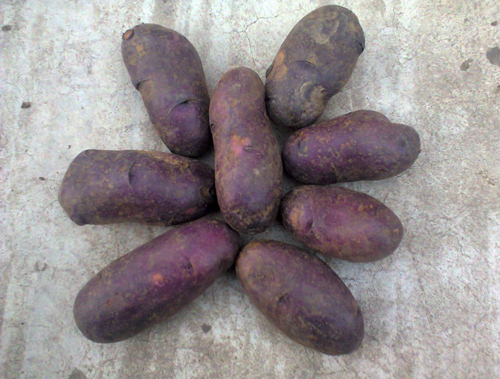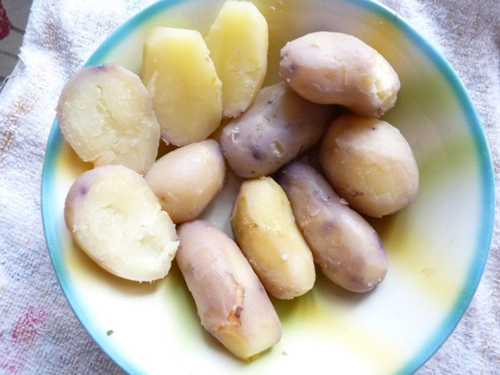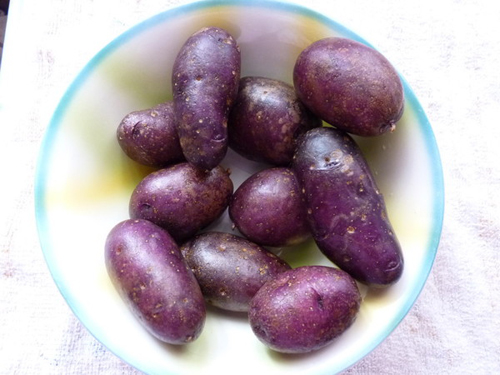Potato variety Gypsy
Gypsy is an amateur potato variety (Solanum tuberosum) for table use. Depending on the climatic zone of growth, it ripens early or mid-early. It is appreciated for its great taste. Differs in a violet color of the peel. Weakly resistant to mechanical damage, does not tolerate transportation. Unsuitable for mechanical cleaning.

A short introduction should be made. Currently, there is debate over whether Gypsy exists at all as a separate variety with a specific set of genetic characteristics. The history of the breeding of this potato is shrouded in a veil of secrecy, however, it is believed that it was obtained by amateurs by crossing Dutch hybrids with a purple peel Black Prince and Blue Danube... The latter is officially registered, but the Prince is the same "dark horse" as our hero. Disputes about its origin also do not subside, some even question its existence. However, this is a completely different story that deserves a separate article.
Some gardeners claim that Gypsy is the same "Chugunka" and "Negritanka". But the first is officially registered and has nothing to do with our hero, and the second is only the general name of varieties with purple pulp, while “our” variety has it white.
Description
The time from the appearance of full shoots to ripening is 70-90 days, depending on the region of growth.
The plant is of medium height, compact, not spreading. Potato stems are dark in color, with a bluish tint. The amount of green mass is average. Leaves are small, dark green in color, with well-pronounced venation. The edges of the leaf plate are slightly wavy. The flowers are large, blue in color. The inflorescences are compact. Berries are rarely formed.
The root system of Tsyganka is well developed, 6-14 tubers are formed in one nest. Commercial potatoes weigh 100-130 grams. The tubers have an oval, often elongated shape, a flat surface without depressions and bumps. The peel is very thin, has a violet color with a bluish tinge and a characteristic glossy sheen. The pulp on the cut is white or light cream in color, inclusions of purple pigment are possible. The eyes are small, uncolored, and their number is small. The depth of their occurrence is superficial. The stolon trace is often depressed, less often flat.

The yield of the variety is noted within 250 c / ha. Marketability at a rather low level due to the heterogeneity of the tubers. They differ markedly in size and weight; the number of commercial specimens in one nest can vary greatly. Keeping quality of potatoes is 92%, however, it is necessary to take a responsible attitude to harvesting - tubers are susceptible to mechanical damage due to their thin peel. Damaged tubers are not suitable for long-term storage - they will begin to rot, while they can spoil the rest of the crop.
Tsyganka's taste is excellent. Our hero is suitable for dietary nutrition, due to the high content of vitamins and microelements in the pulp, including iodine, as well as the relatively low amount of starch - 12-14%. Tuber crops are versatile in cooking, suitable for preparing a variety of dishes, and will show themselves especially well when baked. The pulp boils well, has a very pleasant taste and a truly "potato" rich aroma. It is worth mentioning that despite all the disadvantages of the variety, which we will talk about a little later, gardeners do not stop growing it precisely because of its excellent taste.
The variety is very picky about soil fertility and climatic conditions of growth. It tolerates drought very poorly; in hot seasons, yields are significantly reduced due to an increase in the amount of non-commodity fines in the nest. Regular, abundant watering has a positive effect on the number and size of tubers.
In the care of the plants, they are also quite whimsical, they require timely implementation of agrotechnical measures, such as hilling, loosening the soil, weeding. Particular attention should be paid to the treatment of plantings from pests. At the same time, some gardeners talk about the good resistance of this potato to being eaten by the Colorado potato beetle and wireworm. Whether this is true or not is a rather interesting question, so it's better to play it safe and take the necessary preventive measures.

The variety is resistant to the most common diseases of the nightshade, such as cancer, common scab, gray rot and various viruses. Medium resistant to late blight on tops and tubers, preventive treatments and observance of crop rotation on the site are highly desirable.
Summarizing all the advantages of our hero, one should highlight, first of all, his excellent taste. Many gardeners call Gypsy a gourmet potato and grow it only because of its excellent taste. Of the advantages, one can also note a fairly good yield, but it does not differ in stability, which can already be attributed to the disadvantages.
The main disadvantage of the variety is the low level of marketability and poor resistance of tubers to mechanical damage. These nuances make the variety unsuitable for cultivation on an industrial scale, so its distribution area does not go beyond the personal backyard plots. The crop can be harvested only by hand, moreover, this is quite a "fun" business - tubers are very difficult to "find" in the ground because of their dark purple rind.
Speaking of the cons, one cannot fail to mention the heterogeneity of tubers. There are often a lot of little things in the nest, so it is impossible to collect more than 5-6 specimens of normal size from one plant. Some gardeners also note a deterioration in the taste of potatoes with prolonged storage. Another big drawback is the whimsicality of plants in the care, and especially their exactingness to the level of soil moisture. If you do not have the opportunity to often visit your site and irrigate on time, it is better not to choose this variety for growing.
Perhaps we should summarize. In general, Tsyganka is a good, very tasty potato, but quite exotic both in appearance and in other characteristics, including the characteristics of commercial and consumer qualities, as well as the nuances of agricultural technology. If you are looking for a reliable, stable potato, it is best to look at other varieties. In addition, breeders have already bred enough varieties with purple peels that meet modern high requirements. However, if you really want to have on your site some rare "wonder" with very good taste, then Gypsy is clearly a good choice.









These potatoes are delicious. It doesn't take long to prepare. Loves care. There are a lot of tubers in the bushes. But it needs constant moisture and care for the bushes of the plant themselves. If the summer is dry, there will be a lot of small and beautiful potatoes. Rainy summer - potatoes will be about the size of a medium apple. Stored for a very long time. Before planting, the gypsy germinates well, which increases the chance of yield.
The first time I saw this variety a long time ago at my grandmother's, attracted by the unusual color of the peel. Last year I decided to plant it myself, I had to look for tubers for planting, it was not very popular in our area.Planted in early May, in well-fertilized soil. From time to time she watered, weeded it twice and hilled it once. There was less Colorado potato beetle on this potato than on other varieties, but still there was. They dug in early September, by this time the bushes had already dried up. The potatoes were quite large, but the quantity in the bushes was very different, somewhere there were 7 tubers, somewhere around 10, and where there was only 3. This variety is well suited for cooking, it turns out crumbly and tasty. I selected potatoes for seeds only from fruitful bushes. I store it in the cellar, I'll try to plant it again, I really liked the taste.
This variety was planted for itself, I advise everyone who loves this variety and lives in a rather warm climatic zone to plant a second planting on July 10-20. Thus, there are much fewer small potatoes, the weight of tubers is 60-120 grams, 4-12 pieces per bush. Resistant to late blight and other diseases. Loves moisture. It tolerates frost well under agrofibre.